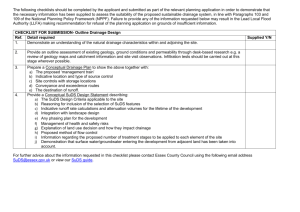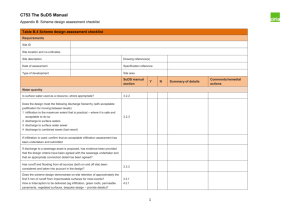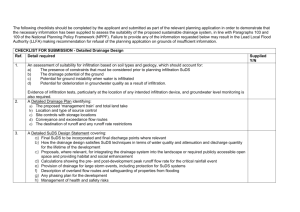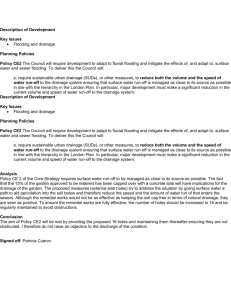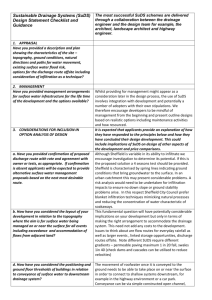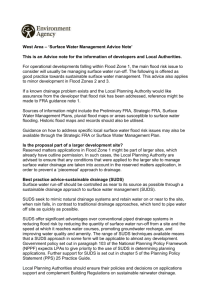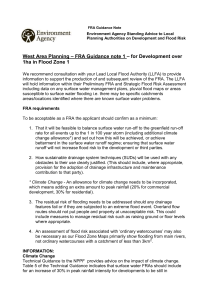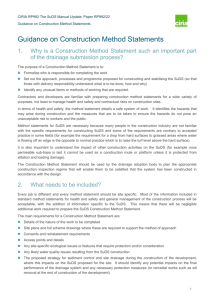West Thames – Surface Water Flood Risk Assessment (FRA
advertisement
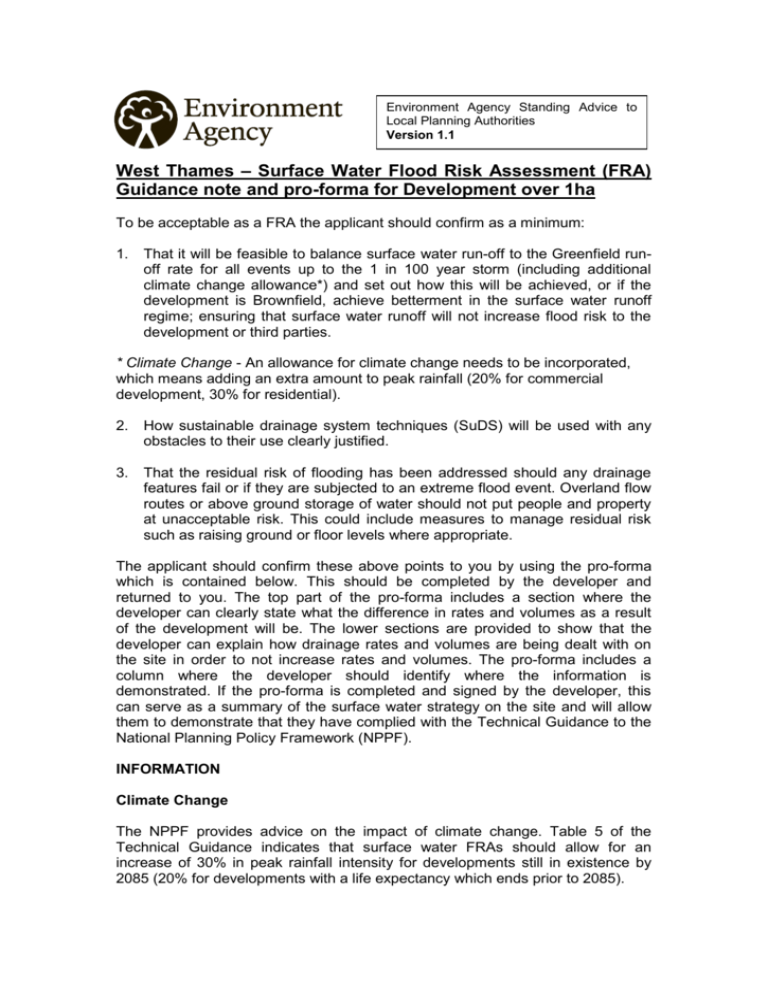
Environment Agency Standing Advice to Local Planning Authorities Version 1.1 West Thames – Surface Water Flood Risk Assessment (FRA) Guidance note and pro-forma for Development over 1ha To be acceptable as a FRA the applicant should confirm as a minimum: 1. That it will be feasible to balance surface water run-off to the Greenfield runoff rate for all events up to the 1 in 100 year storm (including additional climate change allowance*) and set out how this will be achieved, or if the development is Brownfield, achieve betterment in the surface water runoff regime; ensuring that surface water runoff will not increase flood risk to the development or third parties. * Climate Change - An allowance for climate change needs to be incorporated, which means adding an extra amount to peak rainfall (20% for commercial development, 30% for residential). 2. How sustainable drainage system techniques (SuDS) will be used with any obstacles to their use clearly justified. 3. That the residual risk of flooding has been addressed should any drainage features fail or if they are subjected to an extreme flood event. Overland flow routes or above ground storage of water should not put people and property at unacceptable risk. This could include measures to manage residual risk such as raising ground or floor levels where appropriate. The applicant should confirm these above points to you by using the pro-forma which is contained below. This should be completed by the developer and returned to you. The top part of the pro-forma includes a section where the developer can clearly state what the difference in rates and volumes as a result of the development will be. The lower sections are provided to show that the developer can explain how drainage rates and volumes are being dealt with on the site in order to not increase rates and volumes. The pro-forma includes a column where the developer should identify where the information is demonstrated. If the pro-forma is completed and signed by the developer, this can serve as a summary of the surface water strategy on the site and will allow them to demonstrate that they have complied with the Technical Guidance to the National Planning Policy Framework (NPPF). INFORMATION Climate Change The NPPF provides advice on the impact of climate change. Table 5 of the Technical Guidance indicates that surface water FRAs should allow for an increase of 30% in peak rainfall intensity for developments still in existence by 2085 (20% for developments with a life expectancy which ends prior to 2085). Sustainable Drainage Systems (SuDS) Surface water run-off should be controlled as near to its source as possible through a sustainable drainage approach to surface water management. SuDS seek to mimic natural drainage systems and retain water on or near to the site, when rain falls, in contrast to traditional drainage approaches, which tend to pipe water off site as quickly as possible. SuDS therefore offer significant advantages over conventional piped drainage systems and will be applicable to most sites. Government policy set out in paragraph 103 of the NPPF expects Local Planning Authorities (LPAs) to give priority to the use of SuDS in determining planning applications. Further support for SuDS is set out in chapter 5 of the Planning Policy Statement 25 (PPS25) Practice Guide. Approved Document Part H of the Building Regulations 2010 also establishes a hierarchy for surface water disposal, which encourages a SuDS approach beginning with infiltration where possible e.g. soakaways or infiltration trenches. Where SuDS are used, it must be established that these options are feasible, can be adopted and properly maintained and would not lead to any other environmental problems. Where the intention is to dispose to soakaway, these should be shown to work through an appropriate assessment carried out under Building Research Establishment Digest 365. Further information and references on SuDS can be found in chapter 5 of the PPS25 Practice Guide. The Interim Code of Practice for Sustainable Drainage Systems provides advice on design, adoption and maintenance issues and a full overview of other technical guidance on SuDS. The Interim Code of Practice is available electronically on CIRIA's web site at: http://www.ciria.com/suds/interim_code.htm. Disposal of surface water to public sewer Before disposal of surface water to the public sewer is considered all other options set out in Approved Document Part H of the Building Regulations 2010 should be exhausted. When no other practicable alternative exists to dispose of surface water other than the public sewer, the Water Company or its agents should confirm that there is adequate spare capacity in the existing system taking future development requirements into account. Designing for exceedence For on/near site flooding, the PPS25 Practice Guide at paragraph 5.51 states that: “For events with a return-period in excess of 30 years, surface flooding of open spaces such as landscaped areas or car parks is acceptable for short periods, but the layout and landscaping of the site should aim to route water away from any vulnerable property, and avoid creating hazards to access and egress routes (further guidance in CIRIA publication C635 Designing for exceedence in urban drainage - good practice). No flooding of property should occur as a result of a 1 in 100 year storm event (including an appropriate allowance for climate change). In principle, a well-designed surface water drainage system should ensure that there is little or no residual risk of property flooding occurring during events well in excess of the return-period for which the sewer system itself is designed. This is called designing for event exceedence.” The CIRIA publication `Designing for exceedence in urban drainage-good practice' can be accessed via the following link: http://www.ciria.com/suds/ciria_publications.htm For off-site flooding, the PPS25 Practice Guide states at paragraph 5.54: “For the range of annual flow rate probabilities up to and including the one per cent annual exceedence probability (1 in 100 years) event, including an appropriate allowance for climate change, the developed rate of run-off into a watercourse, or other receiving water body, should be no greater than the existing rate of run-off for the same event. Run-off from previously-developed sites should be compared with existing rates, not greenfield rates for the site before it was developed. Developers are, however, strongly encouraged to reduce runoff rates from previously-developed sites as much as is reasonably practicable. Volumes of run-off should also be reduced wherever possible using infiltration and attenuation techniques. Interim guidance on calculation of site runoff rates can be found on the CIRIA website: http://www.ciria.org Is the proposal part of a larger development site? LPAs should be aware that some applications for smaller scale developments might be part of larger sites which already have outline permission. In such cases, the LPA should ensure that any conditions which were applied to the larger site, in relation to surface water drainage, are complied with. Note: Development which involves a culvert or an obstruction to flow on an Ordinary Watercourse will require consent under the Land Drainage Act 1991 and the Floods and Water Management Act 2010. In the case of an Ordinary Watercourse the responsibility for Consenting lies with the Lead Local Flood Authority (LLFA). An Ordinary Watercourse is defined as any watercourse not identified as a Main River on maps held by the Environment Agency and DEFRA. For further information on Ordinary Watercourses contact the LLFA. We would still wish to be consulted on any proposed culverting or an obstruction to flow on a Main River. ENVIRONMENT AGENCY WEST THAMES - SURFACE WATER PRO-FORMA This pro-forma accompanies our surface water guidance note on sites between 1 and 5 hectares. The developer should complete this form and return to the Local Planning Authority and indicate where the evidence is provided within their submission documents for the answers given Site Name Site Size Development Type (Green/Brown field) Discharge Rates 1 in 1 Qbar(1 in 2) 1 in 30 1 in 100 1 in 100 +Climate change (proposed only) Discharge Volumes 1 in 1 Q Bar (1 in 2) 1 in 30 1 in 100 Proposed 1 in 100 +Climate change Existing Proposed Difference Between Existing and Proposed Which Document or Plan is this information contained in Then above section should only show small increases in discharge rate if an increase in discharge volume is shown – otherwise there should be no increase. Note that an increase in discharge volume may be shown in the above table - but how this is being attenuated on site and discharged so as to not increase flood risk should be set out below. If an increase in discharge rate or volume is shown, or if an increase was predicted but has been designed in to the system, please answer the following questions. Discharge Rates (The final scheme should show no increase in discharge rates. If a small increase in rate is shown to address trickle or Q-Bar discharge, then How are increases in discharge rate being dealt with? What storage volume is required as a result of restricting discharge rate? Where has this volume been provided on site? Which Document or Plan is this information contained in Discharge Volumes (Where an increase in volume is shown, that increase in volume must be either attenuated and trickle discharged at 2l/s/ha. Or, the whole of the sites discharge rate must be restricted to Qbar) (Qbar is the run off rate for the site as if it was a Greenfield site i.e. assuming it is undeveloped). Qbar will be higher if the geology of the site is less permeable. Which method has/will be used to control additional discharge volumes? What is the Qbar/Trickle Discharge Rate? As a result of restricting rate, what additional attenuation storage volume was/is required? Where on site will/has this attenuation be provided? How will rates be restricted (Hydrobrake etc)? Which Document or Plan is this information contained in Please also confirm Which Document or Plan is this information contained in No flooding of pipe network will occur in the 1 in 30 event Any flooding or exceedence outside the pipe network will be safely contained on site and not increase flooding elsewhere (please indicate on a plan the location of any flooding). Which SuDS methods have been used on site. If infiltration is proposed - That infiltration rates are acceptable (Provide rate). That infiltration devices or their attenuation areas are appropriately sized. The above form should be completed using evidence from the Flood Risk Assessment and site plans. It should serve as a summary sheet of the drainage proposals and should clearly show that the proposed rate and volume as a result of development will not be increasing. If there is an increase in rate or volume, the rate or volume section should be completed to set out how the additional rate/volume is being dealt with. This form is completed using factual information from the Flood Risk Assessment and Site Plans and can be used as a summary of the surface water drainage strategy on this site. Form Completed By…………………………………………………………………………………….., Company……………………………………………………………………………, Date:…………………………….
